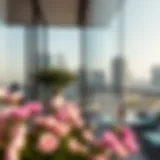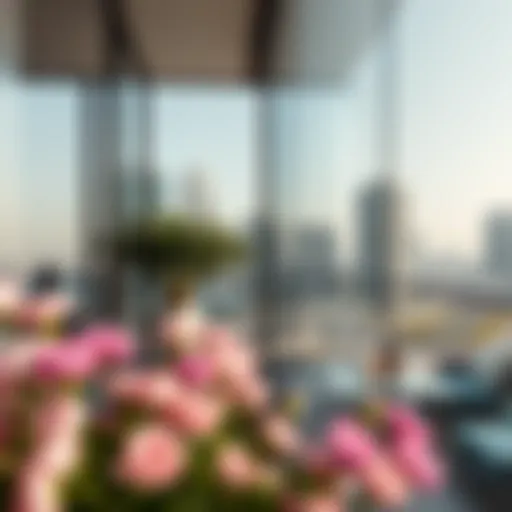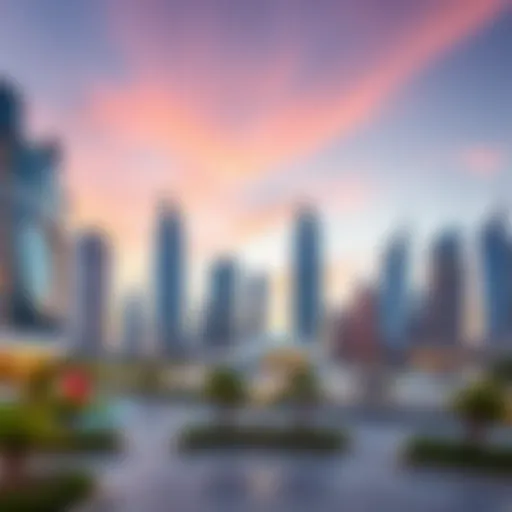Exploring Dubai's Architectural Evolution and Innovation
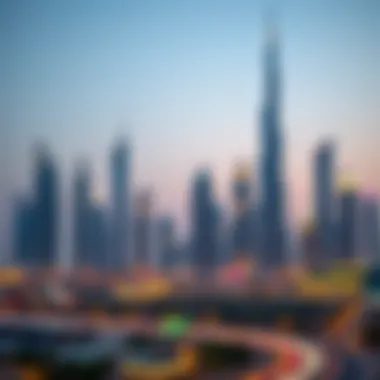

Intro
Dubai's architectural scene is nothing short of spectacular, merging traditional Arab styles with futuristic visions. As the sun sets over the skyline, one can easily spot towering structures that have come to symbolize this dynamic city. Each building tells a story, reflecting both the past and the aspirations for the future. This unique blend not only attracts tourists but also investors and architects eager to share in its growth.
The evolution of Dubai's architecture showcases a remarkable journey. What began as a modest fishing town has transformed into a global hub bustling with innovation and creativity. To truly grasp this metamorphosis, it’s essential to explore the many aspects that contribute to the architectural landscape here.
Property Trends in Dubai
As Dubai continues to evolve, its property market is shaped by trends that highlight emerging neighborhoods, investment opportunities, and sustainability practices. Understanding these trends is vital for investors and homeowners alike.
Emerging Neighborhoods and Hotspots
Dubai's neighborhoods are rapidly transforming, with new hotspots sprouting up all over the map. Areas like Dubai Marina and Downtown Dubai remain popular, yet up-and-coming locales like Jumeirah Village Circle and Dubai Hills Estate are gaining traction. These neighborhoods offer a blend of residential, commercial, and leisure spaces, making them attractive to a diverse range of buyers.
- Jumeirah Village Circle (JVC): Known for its affordable villas and townhouses, it attracts families looking for community living.
- Dubai Hills Estate: This area features an 18-hole championship golf course and premium estates, appealing to luxury buyers.
The emphasis on mixed-use development is a compelling aspect of these neighborhoods, encouraging a balance between living, working, and recreation.
Market Analysis and Future Predictions
The current property market in Dubai showcases a blend of stability and growth potential. After a period of correction, property values are stabilizing, leading experts to predict a healthy increase over the next few years. Factors such as the upcoming Expo 2020, advancements in infrastructure, and a strong global economy are fueling interest.
- Investors should focus on properties that offer high rental yields and capital appreciation.
- More sustainable architecture is expected to gain focus, aligning with global trends where eco-friendly designs seriously impact buying decisions.
"Dubai’s architectural evolution is not merely about buildings; it’s a reflection of cultural progress, sustainability, and modern living."
In summary, the property trends point toward a bright future for Dubai's architecture and urban development. This city is not only building structures but also creating a lifestyle that echoes the waves of change resonating around the globe.
Investment Opportunities
When it comes to investing in Dubai, one cannot overlook the myriad of opportunities available. The potential for high returns is attractive, but understanding the nuances of the market is crucial for any serious investor.
High-ROI Property Types
Investors keen on maximizing returns should consider several property types:
- Luxury Apartments in established areas like the Burj Khalifa and Palm Jumeirah
- Commercial Spaces in the Dubai International Financial Centre (DIFC)
- Off-Plan Developments, which offer early-bird prices and are expected to rise sharply in value upon completion
Each of these sectors caters to different market segments, making for a diverse investment portfolio.
Financing and Mortgage Options
Navigating the financing landscape in Dubai can seem daunting. However, various options tailored to both local and expatriate buyers can greatly ease the process. Banks offer competitive mortgage rates and flexible payment plans, often with low down payments for expatriates and first-time buyers.
- An excellent resource is the Dubai Land Department, which provides guidelines and financial information for investors looking to finance their property purchases. Interested buyers can find more details at www.dubailand.gov.ae .
Armed with knowledge about market trends and investment opportunities, investors can make informed decisions that resonate with Dubai's rapid growth and vibrant architecture. The interplay between innovation, sustainability, and cultural heritage positions Dubai as an architectural marvel flourishing on the global stage.
Prologue to Dubai's Architectural Identity
The architectural identity of Dubai is not just a reflection of modernity; it is an intricate tapestry woven together with threads of history, culture, and innovation. To truly grasp the significance of Dubai's skyline, one must first recognize how this desert metropolis transformed under the sands of time and evolving global dynamics.
Dubai's architectural journey illustrates a remarkable evolution from humble beginnings to the epitome of avant-garde design. This story captures the essence of a city that—over decades—has attracted investors, homeowners, and developers seeking to partake in its architectural renaissance. The intense growth and wealth infusion have not only shaped the city but redefined what architectural identity can signify in the context of fast-paced urbanization.
The Historical Context
Understanding the historical context is essential for appreciating Dubai's architectural identity. A few decades ago, Dubai was largely a trading port with modest structures and a predominantly nomadic lifestyle. The discovery of oil in the 20th century catalyzed a dramatic transformation. During this period, the need for infrastructure and housing surged, setting the stage for a groundbreaking architectural evolution.
Old wind-tower structures dotted the landscape, once symbols of traditional Emirati life, were gradually overshadowed by towering skyscrapers made from glass and steel. This juxtaposition speaks volumes about the city’s journey: from ancient trades to contemporary cosmopolitanism.
Traditional Emirati Design
When delving into traditional Emirati design, it is important to highlight its role in providing authenticity and a sense of belonging amidst rapid change. This type of architecture embodies local values and environmental adaptability, resonating both socially and culturally.


Materials and Techniques
Materials used in traditional Emirati buildings largely derived from local resources, including coral stone, mud, and palm fronds. This resourcefulness exemplifies a characteristic that prioritizes sustainability and practicality. For instance, coral stone, with its natural insulation properties, made buildings cooler in the sweltering desert heat.
Utilization of these materials not only showcases a commitment to local craftsmanship but also results in buildings that harmonize with their surroundings, ultimately creating a unique environment that reflects the Emirati ethos. The downside, however, is that much of this architectural style may risk being overshadowed by modern counterparts, which leads to a potential loss of heritage.
Cultural Significance
Cultural significance in Emirati architecture cannot be overstated. The designs carry stories of the people and reflect values deeply entrenched in the fabric of society. Take the Bari, for instance; it is more than just a solar pavilion. It serves as a communal social space, illustrating the importance of hospitality in Emirati culture.
Such connections to communal identity in architecture serve to reinforce bonds within neighborhoods and maintain a sense of belonging. However, as Dubai pushes forward with its modern skyline, this cultural aspect runs the risk of fading amidst the sea of glass and steel, leaving a void in the narrative of its architectural identity.
Feeling the heartbeat of Dubai’s architecture means navigating through these past experiences while embracing the future. It’s a delicate balance of progress and heritage, where every structure tells a tale and presents a unique perspective. As we explore further, we'll see how iconic structures build on this rich foundational narrative, shaping the perception of Dubai as an architectural marvel and a beacon of modernity.
Iconic Structures and Their Impact
In the realm of architecture, the structures that stand tall often mirror a city’s values, aspirations, and cultural narrative. Dubai, with its skyline punctuated by innovative edifices, serves as a prime example of how architecture can shape not just a city, but also the experiences of its inhabitants and visitors alike. The impact of these iconic structures extends far beyond aesthetics; they deeply influence economic activities, cultural identity, and even social interactions. Understanding the significance of such landmarks helps us appreciate the architectural landscape as a complex tapestry woven with tradition, technology, and vision.
Burj Khalifa: A Symbol of Modernity
Design and Engineering
The Burj Khalifa stands as a testament to modern engineering prowess. Soaring to a height of 828 meters, it's not just the tallest building in the world; it’s a feat of human ingenuity. Designed by Adrian Smith from Skidmore, Owings & Merrill, the structure employs a unique triple-lobed footprint, which optimizes wind resistance—a crucial aspect considering the desert winds of Dubai.
The building’s core utilizes a reinforced concrete system, providing exceptional stability. To accommodate the diverse demands, the engineering team incorporated state-of-the-art materials that ensure durability while being lightweight. This choice of design and engineering allows Burj Khalifa to function not just as an office and residential space but as an entertainment hub, complete with observation decks and luxury amenities.
"The intersections of functionality and form in Burj Khalifa demonstrate how modern design can both inspire and serve."
Cultural Reception
The Burj Khalifa has reverberated through global consciousness as a cultural icon, symbolizing aspiration and luxury. Its striking silhouette has been depicted in films, photographs, and art, creating a recognizable brand for Dubai worldwide. The building’s opening was met with anticipation and acclaim, drawing numerous visitors and media attention, establishing it as a must-see attraction.
However, the cultural reception isn't universally positive. Some critics argue that such a monumental structure fosters a superficial image of wealth, overshadowing other cultural narratives. Yet, its unique architectural elegance has undeniably played a role in reinforcing Dubai’s status on the global stage, captivating both tourists and investors alike.
Burj Al Arab: The Luxury Landmark
Construction Challenges
Constructed on an artificial island, the Burj Al Arab presents its own unique set of challenges. Building a luxurious hotel shaped like a sail required not only groundbreaking design but also robust engineering to address the external forces acting upon it. The foundation of the structure has to be particularly resilient, as it rests on 230 concrete piles buried deep into the seabed to withstand the forces of both wind and waves.
These construction challenges didn’t deter the vision; they pushed engineers and builders to innovate. Each obstacle encountered became a stepping stone to achieving one of the most recognized luxury hotels in the world. On the flip side, these challenges increased costs and timelines, creating barriers that only seasoned investors could navigate.
Architectural Innovation
Burj Al Arab's design is groundbreaking, showcasing the concept of luxury through architecture. The hotel’s atrium, rising 180 meters, is a sight to behold, adorned with golden accents and bespoke furnishings. It incorporates traditional Islamic designs while pushing the envelope of modern architecture with its sail-like structure, giving an impression of floating on water.
This innovation is significant as it doesn’t merely cater to luxury but also emphasizes Dubai’s rich cultural heritage, intertwined with cutting-edge technology and design. The hotel has sparked a trend in luxury hospitality, inspiring similar structures across the globe. Yet, it raises questions regarding sustainability and resource allocation, challenges that any future iconic structure may need to address.
Dubai Mall: The Retail Experience
Architectural Features
Dubai Mall, one of the largest shopping malls in the world, takes shopping to a new level, merging architectural brilliance with consumer experience. Spanning over 1.1 million square meters, it houses not just shops but an aquarium, an ice rink, and numerous dining establishments, all under one striking, glass-covered roof. The mall's layout is designed to facilitate foot traffic, with wide corridors and inviting spaces, blending retail with leisure seamlessly.
The architectural features of Dubai Mall convey a sense of grandeur that enhances the shopping experience. The use of natural light, massive atriums, and thematic zones contribute to an environment that's inviting and dynamic. However, the sheer scale poses management challenges, particularly during peak tourist seasons when it is swarmed with visitors.
Impact on Tourism
The Dubai Mall doesn’t just attract shoppers; it is a tourist magnet. The sheer scale and diversity of experiences create a gravity that draws millions annually, contributing significantly to the local economy. Visitors flock not just for shopping, but also to experience its entertainment offerings, which range from fashion shows to underwater adventures.
This impact on tourism is crucial. It helps establish Dubai as a leading retail and entertainment destination, providing jobs and bolstering other sectors like hospitality. Nevertheless, the overwhelming influx of tourists raises concerns about sustainability and the need for better infrastructure to cope with such high numbers all year round.
By focusing on these iconic structures, we can grasp not only the architectural techniques and innovations at play but also their broader implications on culture, economics, and urban life in Dubai. These iconic landmarks reflect a city in constant evolution, with the courage to push boundaries while navigating the challenges that arise.
The Role of Urban Planning in Dubai's Growth
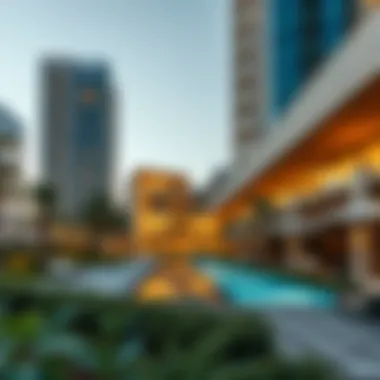

Urban planning in Dubai has emerged as a pivotal element in shaping the city’s architectural narrative. Its growth presents both challenges and opportunities, necessitating a comprehensive approach to urban design. Urban planning in Dubai is not merely about constructing new structures; it’s about creating a cohesive environment that integrates various aspects of life—residential, commercial, and recreational—thus fostering a livable urban space. As the city continues to evolve, the role of urban planning becomes even paramount.
Vision 2021: Strategic Goals
In 2010, the government of Dubai released Vision 2021, setting strategic goals aimed at enhancing the quality of life and positioning Dubai as a global hub. This long-term plan is a blueprint for sustainable growth, integrating economic, social, and environmental dimensions into the city’s core development strategies.
Sustainability Initiatives
One of the standout aspects of the sustainability initiatives under Vision 2021 focuses on reducing the carbon footprint and promoting green technologies. This initiative contributes to the overall goal of making Dubai a sustainable metropolis aligned with international standards.
The key characteristic of these initiatives is the emphasis on renewable energy sources, such as solar and wind power, along with waste management policies aimed at recycling and reducing waste. This is a popular choice for many stakeholders, including investors and developers, given the growing global focus on sustainability.
A unique feature of the sustainability initiatives is the Dubai Clean Energy Strategy 2050, which aims to source 75% of energy from clean and renewable resources by 2050, positioning Dubai as a leader in sustainable urban development. While these initiatives are ambitious, they also face challenges, such as the need for significant investment and the continuous updating of regulations to keep pace with technological advancements.
Cultural Projects
Cultural projects under Vision 2021 represent another critical component, aiming to promote cultural tourism and ensure the preservation of Dubai’s heritage. These projects play a significant role in enhancing the city's global image, contributing to social cohesion while attracting foreign investment in cultural sectors.
The hallmark of these cultural projects lies in initiatives like the Dubai Culture and Arts Authority, which focuses on a series of art exhibitions, festivals, and performances to celebrate the city's rich heritage and multicultural environment. This approach not only enhances cultural understanding but serves as a beneficial endeavor for both residents and tourists alike.
A distinctive aspect of cultural projects is the establishment of landmarks like the Louvre Abu Dhabi, which showcases not only art but also the narrative of interconnectedness among civilizations. However, cultural projects may face obstacles as communities navigate the tensions between rapid modernization and the need to sustain their unique identities.
Master Planning: Integrating Spaces
Master planning in Dubai is another crucial facet of urban development, which aims to integrate spaces effectively. It focuses on creating a balanced distribution of land use to foster connectivity and accessibility. This kind of planning is essential for managing the rapid population growth that Dubai has experienced over the past few decades.
Zoning Regulations
Zoning regulations in Dubai establish guidelines for land use, determining what types of buildings can be constructed in various areas. These regulations are fundamental in ensuring that urban expansion aligns with the overall growth strategy of the city.
The crucial feature of zoning regulations is their flexibility, allowing for mixed-use developments that combine residential, commercial, and recreational facilities. This adaptability makes them an attractive choice for urban planners, as it promotes efficiency and enhances urban living.
However, zoning regulations can also have drawbacks. Restrictive policies might inhibit creative architectural designs, resulting in homogeneous neighborhoods lacking character. Balancing regulation with innovation is essential for the future urban landscape of Dubai.
Public Spaces
Public spaces in Dubai play a vital role in nurturing community engagement and enhancing the quality of life for residents. Parks, plazas, and recreational areas are designed to encourage social interactions among diverse communities.
These spaces are not just green patches in the urban landscape; they represent the character of the city. Public spaces are critical for promoting well-being, recreation, and relaxation, making them a highly beneficial addition to urban planning in Dubai.
A notable feature of public spaces is their multifunctionality—serving as venues for events, markets, and cultural celebrations. While they enrich urban life, the challenge remains to ensure that these spaces are accessible to all residents, regardless of socioeconomic status. Without careful planning, public areas may end up catering to a limited demographic, undermining their overall purpose.
Emerging Architectural Trends
Dubai's architectural landscape is not only shaped by its past but also by the burgeoning trends that are making waves in the realm of construction and design. Emerging architectural trends reveal the city's adaptive nature, showcasing an emphasis on sustainability, technological advancement, and an innovative approach to urban planning. These trends are not just passing fads; they represent a fundamental shift in how spaces are designed, built, and interacted with.
Sustainable Design Practices
A significant pillar of current architectural trends in Dubai is sustainable design practices. These are not just good for the environment, but they also align with global standards and governmental goals for reducing carbon footprints. Green Building Standards stand out in this regard. These standards promote energy efficiency, resource conservation, and eco-friendly materials in construction.
Green Building Standards
Green building standards are essential in pushing architectural boundaries towards sustainability. They are characterized by their emphasis on minimizing environmental impact while maximizing occupant comfort and utility. For instance, a key characteristic is the requirement for buildings to be energy-efficient, which involves innovations such as solar panels and efficient insulation systems.
Using green materials, such as recycled steel or bamboo, not only benefits the environment but can also reduce costs in the long run. One unique feature is the practice of water conservation systems—these use gray water recycling methods that can significantly cut down on water usage while maintaining lush greenery in urban environments. However, some challenges arise, like the initial investment costs and the need for skilled labor to implement these advanced systems effectively.
Innovative Materials
On the other hand, the fascination with innovative materials has opened new niches in the market, contributing to Dubai's architectural evolution. These materials often exhibit superior durability, lower environmental impact, and enhanced functionality compared to traditional options.
Among these innovative choices is self-healing concrete, known for its ability to repair cracks automatically, thus prolonging the life of structures. The key characteristic here is its long-term benefits and reduction of maintenance costs—a considerable draw for builders and investors alike. An interesting point about innovative materials is their adaptability; for instance, modular construction elements can streamline the building process significantly. Yet, some concerns do remain, notably around the substantial cost of research and development and potential regulatory hurdles in their usage.
Smart Cities and Technology
As Dubai aims to establish itself as a leading smart city, the integration of technology in architecture indicates a transformative period in urban living. Smart buildings, powered by digital integration in architecture, make every square meter more functional and efficient.


Digital Integration in Architecture
This aspect incorporates intelligent systems that manage energy consumption, maintenance, and even enhances resident experiences. For example, building management systems that adjust power usage based on occupancy can both save energy and reduce costs for owners. The popularity of this approach stems from its efficiency and the potential for greatly improved quality of life. Unique features include responsive systems that can change lighting and temperature based on the time of day or occupancy levels, ensuring optimal comfort. However, reliance on technology can lead to challenges, particularly regarding privacy concerns and the need for constant technical support.
Future of Urban Living
The concept of the future of urban living stands out during discussions of Dubai’s architectural shifts. This vision encompasses not just spaces to work or live, but entire ecosystems designed for well-being and interconnectivity. A noteworthy characteristic is walkability; developments are being designed with pedestrian-friendly pathways, parks, and integrated public transport systems to encourage healthier lifestyles.
The unique feature of this trend is its holistic development approach, merging work, leisure, and social activities, which can foster a strong sense of community. Nevertheless, striking a balance between modernity and the traditional cultural fabric of Dubai poses its challenges. Ensuring that advancements do not marginalize community engagement can be a vital aspect for city planners.
Through the lens of these emerging trends, Dubai is positioning itself as a forerunner in modern architecture, harmonizing innovation with functionality and sustainability. The converging of progressive practices is paving the way for a future that resonates with investment opportunities, enhancing value for developers, agents, and homeowners alike.
Investing in sustainable and smart infrastructure is no longer an option, but a necessity for future-proofing Dubai's architectural landscape.
Architectural Education and Community Engagement
The architectural education landscape in Dubai is pivotal for shaping the city’s future. As an architectural hub, Dubai not only attracts global talents but also invests in developing local expertise. Thus, the interplay between education and community engagement serves as a catalyst for sustainable design practices and innovation in urban development. The active participation of the community is also instrumental in ensuring that architectural designs meet the actual needs of those they serve.
Universities and Programs in Dubai
Curriculum Overview
Dubai hosts several universities and programs that focus on architecture and urban planning, including the American University of Sharjah and the University of Dubai.
A key characteristic of these programs is their focus on sustainability. Many courses integrate modern sustainability practices into traditional architectural education. This approach is beneficial for prospective architects aiming to work in a region known for its rapid growth and development.
However, one unique feature of the curriculum at these institutions is the blend of theoretical knowledge with practical application. Students often engage in hands-on projects that connect classroom learning with real-world challenges. While this adds immense value, it often poses a challenge; balancing theoretical depth with applied knowledge can be tricky, sometimes leading to superficial understanding of complex architectural concepts.
Research Contributions
Research contributions from these institutions play a substantial role in informing architectural practices in Dubai. Universities engage in innovative research that addresses current issues like climate change, urban density, and community-oriented design.
One defining aspect of this research is its interdisciplinary nature. Collaboration between faculties of engineering, environmental science, and social studies enhances the impact and relevance of architectural research. This interdisciplinary approach makes the research particularly potent, however, it can also dilute specific architectural focus. This fusion potentially creates solutions that are holistic but may risk losing specialized insights if not managed correctly.
Public Involvement in Design
Workshops and Events
Public workshops and events significantly bolster community involvement in architecture. These forums allow ordinary citizens to express their opinions and contribute ideas to the design process.
The main advantage of such events is their inclusive nature. Engaging the public fosters a sense of ownership over local developments. However, organizing these events requires careful planning; if not executed properly, they might lead to confusion or disengagement, instead of fostering collaboration.
Community Projects
Community projects are another significant aspect that enhances engagement and collaboration in architecture. Initiatives like school workshops offer students and local residents the chance to partake in urban design activities. This is key because it helps instill a sense of responsibility towards their environment.
A notable feature of community projects is their ability to promote social cohesion. They not only serve educational purposes but also strengthen ties within various community groups. On the downside, these initiatives often run into challenges of funding and resource allocation, which can affect their sustainability and overall impact.
Investing in education and community engagement equips Dubai’s future architects with the tools needed for innovative, sustainable developments that resonate with the community’s needs.
The evolving architectural scene in Dubai relies heavily on a well-prepared workforce and an engaged public. By fostering education and community participation, the city sets itself on a path toward a thoughtful and inclusive architectural legacy.
End: The Future of Dubai's Architecture
As we wrap up our journey through the architectural gems of Dubai, it's crucial to reflect on the future that lies ahead for this bustling metropolis. The city’s architectural landscape is not just about striking buildings and lavish designs; it’s about harmonizing innovation with the rich heritage that gives Dubai its unique identity. Investors and developers have a chance to not just shape buildings but to shape an experience, one that resonates with both the local culture and the international community.
Balancing Innovation and Heritage
The challenge of balancing cutting-edge innovation with the deep-rooted heritage of Dubai is a tightrope walk, yet it is necessary for creating a sustainable future. Modern architects and planners are realizing that avant-garde designs can coexist with traditional elements, creating a skyline that tells a story. Buildings like the Al Fahidi Historical Neighborhood stand as testaments to how historic architecture can inform contemporary design.
Integrating local materials, cultural motifs, and civic spaces can lead to designs that pay homage to the past while catering to modern needs. Consider the Dubai Creek Tower, which not only aims to be a feat of engineering but also strives to connect with the cultural narrative of the area. This collaboration between past and present serves as a blueprint for how future structures may evolve, appealing to residents and tourists alike.
The Role of Global Influence
Dubai’s architecture is also heavily shaped by global trends and influences. The city’s openness to international architecture and design practices invites a rich tapestry of styles that reflect its status as a melting pot of cultures. As Dubai continues to attract global talent, its skyline becomes more diverse, showcasing designs inspired by different eras and methodologies.
This global influence introduces new concepts and technologies, but it also brings a set of challenges. How can Dubai remain true to its identity while embracing these diverse inputs? The answer lies in selective integration, carefully choosing elements that complement local customs and values, fostering a unique architectural voice.
"Dubai's architectural future doesn't just build upwards; it builds across cultures and histories, crafting spaces that are as rich in narrative as they are in design."
In summary, as Dubai looks towards the horizon, it must adopt a dual approach that cherishes its past while wholeheartedly embracing the future. By keeping a keen eye on sustainability, innovation, and cultural relevance, Dubai stands to not just define, but also inspire, the architectural landscape of tomorrow.
